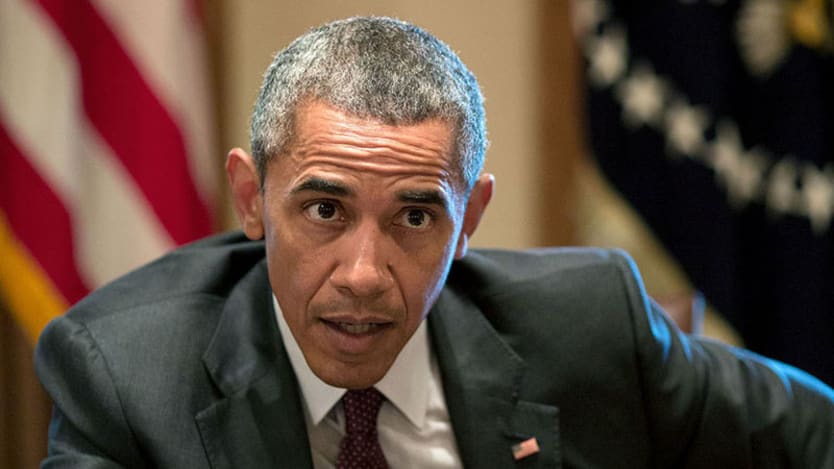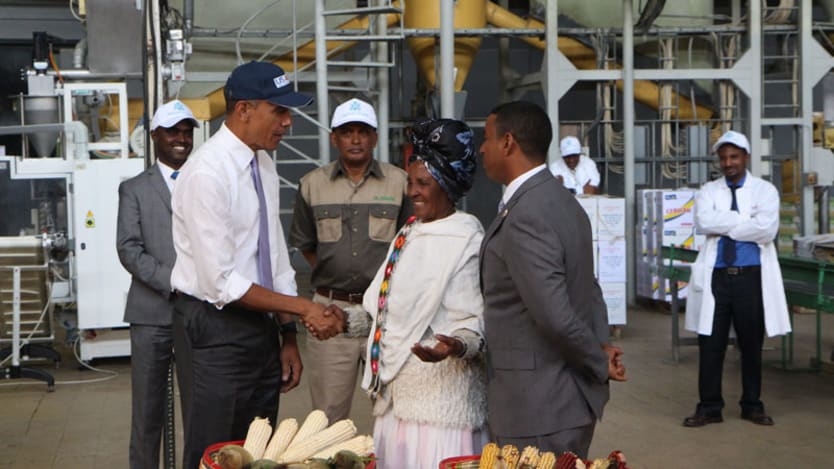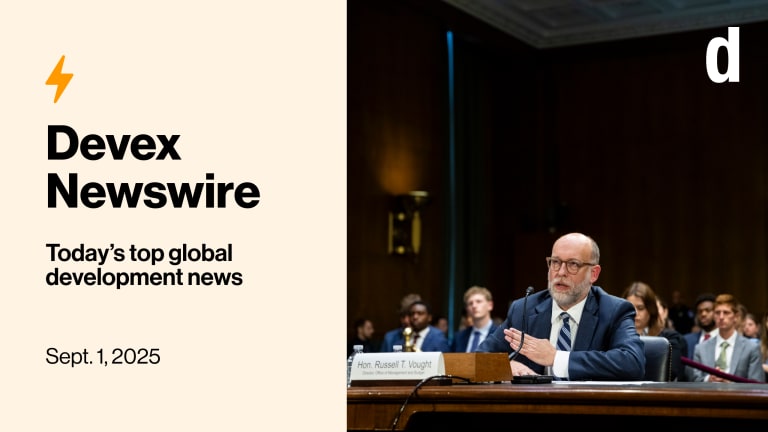
EDITOR’S NOTE: The Bush and Obama administrations oversaw unprecedented changes to U.S. global development programs and institutions during the last 16 years. With the next U.S. presidential election underway, this two-part series takes a close look at the legacy of the last two administrations to help inform our community’s thinking about what’s in store for the next administration — something we will be covering extensively in the coming months. In commissioning this work, Devex has relied on the author’s informed analysis based on interviews with more than a dozen development experts and our editors have made every effort to produce an objective and nonpartisan analysis. Still, we realize any attempt to assess government performance is subject to critique and dispute so we welcome additional perspectives and comments from our readers. For the many development professionals around the world impacted by American development policy, we hope this chronological history provides an opportunity to reflect on past successes and failures and anticipate the future direction of the world’s largest donor country.
Seven years is a relatively brief stretch of time, but it is easy to forget that absolute tumult that greeted President Barack Obama as he stepped into the presidency in January 2009. The global economy was being shaken to its core. More American workers had lost jobs in 2008 than in any year since World War II. Some 800,000 more Americans lost their jobs in just Obama’s first month in office.
Major American carmakers teetered on the edge of collapse, government-sponsored enterprises Fannie Mae and Freddy Mac had already been taken over by the government, and investment company Lehman Brothers dissolved into bankruptcy.
A massive $787 billion economic stimulus package championed by President Obama passed in February 2009 — without a single vote from House Republicans (signaling the divisiveness that was to come). Making matters worse, wars in Iraq and Afghanistan raged on unabated, further draining lives and resources at a time when Americans had long since lost their appetite for foreign adventurism and were pre-occupied with their own increasingly perilous economic situation.
It was not a promising environment for a president to make substantial commitments on the global development front. While candidate Obama had pledged on the campaign trail to double U.S. assistance to Africa by the end of his first term, that seemed like a pipe dream in the turbulence of 2009.
And much to the frustration of the development community, movement on development was very slow coming out of the gate for the administration. Some of this was predictably, and forgivably, due to the crush of dealing with a global economic crisis and two hot wars unfolding halfway across the globe. But some of the initial difficulties on the development front were also of the administration’s own making.
Appointments for key political positions in charge of the development portfolio moved glacially, particularly at U.S. Agency for International Development. Much of this came as a result of the fact that appointees had to be blessed by both the Obama White House and Secretary Hillary Clinton’s team at the State Department — with memories of the bitter primary battle between the two never that far from mind. Many candidates fell out of favor for having leaned too enthusiastically into the Obama or Clinton camps along the way.

Looking for a new USAID administrator
After nine months with no nominee to head USAID, Sens. Richard Lugar and John Kerry pleaded with the administration in a joint letter, “We believe that time is of the essence, and that the longer we wait for a new leader for the agency, the more serious the problems become." The physician Paul Farmer, who has always been more celebrated on the lecture circuit than among development professionals, briefly emerged as a leading candidate to run USAID before pulling his name from consideration.
Adding to the growing unease with the lack of key appointments was the fact that the administration had launched two key strategic reviews of the U.S. government’s approach to development. The White House announced a Presidential Study Directive on Global Development Policy as the State Department kicked off the first Quadrennial Diplomacy and Development Review, or QDDR, modeled upon a similar strategic planning exercise at the Pentagon.
The QDDR review was elaborate and sprawling as a seemingly never-ending series of working groups and consultations spread out from Foggy Bottom. As one nonpartisan aid watcher described, “The process took forever and was horrible. The QDDR it produced was way too long, it was in direct competition with the Presidential Study Directive, and USAID was badly disadvantaged throughout because it has mostly acting officials in key leadership positions.”
As deadline after deadline shifted, waiting for the QDDR to be completed became something of a running joke among think tanks and nongovernmental organizations in Washington. As Nancy Birdsall, the president of the Center for Global Development commented, “The feeling then was: ‘What is going on? Is it all about process?’”
But eventually the various logjams broke. Rajiv Shah was confirmed as administrator of USAID the day before Christmas of 2009, his selection facilitated by the fact he had been confirmed for his previous position at the U.S. Department of Agriculture not long before. In September 2010, Obama signed the Presidential Study Directive and in December of that same year Clinton released the first QDDR. (The slow roll of the strategic reviews also effectively doomed congressional efforts, led by Rep. Howard Berman, to pass major aid reform legislation during this period. By the time the QDDR was released in 2010 Democrats had lost control of the House. The window for a collaborative approach to reform legislation had closed.)
While the sausage-making of the Obama administration’s early approach to development was not pretty, a number of important decisions emerged from this period that go directly to the administration’s development legacy. The Presidential Study Directive on Development, with its emphasis that “sustainable development is a long-term proposition, and progress depends importantly on the choices of political leaders and the quality of institutions in developing countries” got very positive reviews. (“All the right decisions on paper,” said one person I interviewed.) And while noting that implementation of the study directive has at times been uneven, one Washington think tank expert added, “Kudos to the administration for referring to the study directive so long and so often, it is like the magna carta to these people.”
Perhaps most importantly in the early part of the administration, Obama approached the aid system left by his predecessor with considerable wisdom. To its credit, the administration did not throw the baby out with the bathwater. Obama preserved the Millennium Challenge Corp., and maintained a substantial commitment to PEPFAR. In a move widely lauded by health experts, he also gradually, but decidedly, shifted PEPFAR to much more of a health systems approach. The U.S. would remain the global leader in combating HIV and AIDS, but developing countries would have to share a portion of that burden and better step up to manage their own approach to health as a whole.
But Obama was also firm in reversing Bush-era approaches that he just didn’t think made sense. The Obama administration re-established a policy shop at USAID and slowly gave USAID back some, but not all, authority over its budget. And while these may sound like mere bureaucratic box shuffling to the uninitiated, a federal agency without control of its budget or the ability to formulate policy is a very weak sister indeed. Having real policy expertise is critical if you are going to get development right. As Nora O’Connell of Save the Children observed, re-establishing the policy shop was “one of the biggest successes” of the early process decisions, and it help re-establish USAID as a thought leader on development and give it a seat at the table in broader discussions with the State Department and the White House.
Linked to the decision to re-establish the policy shop was a renewed emphasis on using evaluations to determine what works and what doesn’t work on the ground in development. USAID had largely stopped conducting evaluations after its former evaluation shop was disbanded under budget pressure in the late 1990s. As Shah said in January 2011, “I expect us to succeed in some of our efforts, and to fall short in others. I expect a strong evaluation function and feedback loop that enables us to be accountable in both cases, and to learn from each.”
There was always an eagerness within the Obama team to create a lasting development legacy. But there was also a realization that they were at a severe disadvantage vis-a-vis the Bush administration when it came to creating such a legacy. The Bush team had created the MCC and PEPFAR, massive new commitments on top of already inflated war-time investments in reconstruction in Afghanistan and Iraq, at a time when Congress seemed to fall over itself offering new money and authorities to the president.
With the economic crisis and Republicans in Congress reflexively opposing anything proposed by President Obama, the days of wine and roses were gone. If the Obama Administration wanted to create a lasting development legacy, such plans would have to be largely “budget neutral” and not require Congressional authorization. Any number of bold plans were simply nonstarters.
USAID reforms
President Bush and his development legacy
On balance the Bush administration brought great sweeping, almost operatic, successes and failures and a nearly unrivaled boom in resources. It was a track record that naturally lent itself to discussions of legacies both good and bad.
It was against this backdrop of trying to do more with less that Shah announced the first major reform that he seemed to “own” from conception to implementation in January 2011. With blazing remarks guaranteed to generate headlines, Shah complained of an aid-industrial complex, and decried, “Our industry is full of incentives designed to prolong our efforts rather than reduce them or enable transitions. As a result, handoffs rarely happen. Projects are extended in perpetuity while goals remain just out of reach. There's always another high-priced consultant that must take another flight to another conference or lead another training.”
Shah pointed out that more than 90 percent of USAID’s grants and contracts went to U.S. NGOs and for-profit firms and insisted, that his agency would no longer be “writing big checks to big contractors and calling it development.” His solution: setting a target of 30 percent funding to be directed to developing countries governments and NGOs.
Shah was spot on in making the case development should be about building the capacity of local partners over time. But Shah’s rollout of “procurement reform” — as it was initially dubbed — underscored that the USAID administrator still had a lot to learn about how politics were played in Washington.
Shah’s rhetoric was ham-handed, the branding for the initiative was poor (one NGO official interviewed for this story called procurement reform “the worst named reform ever”), there were few outside consultations with the Hill or other key stakeholders in advance of the plan’s announcement, and Shah unconstructively lumped together for-profit contractors and nonprofit NGOs. For-profit contractors quickly mobilized against the agenda with adroit and expensive lobbying on the Hill, and USAID engaged in furious damage control.
To the credit of all involved, things eventually got on better track. The administration came to realize that genuinely building capacity on the ground was more labor-intensive than they had initially imagined. NGOs warmed to procurement reform (redubbed “local solutions”) and provided important support for the effort.
And while for-profit contractors still don’t love the idea, they achieved a certain détente with the administration on the concept as Shah and others increasingly distanced themselves from a hard 30 percent target. Embracing local solutions marked a very important institutional shift, and it has the potential to offer benefits for years to come.
Knowing that a huge infusion of cash from the Congress was unlikely for new aid initiatives, the administration tried to bundle together areas of existing activities with a sprinkling of new approaches, new ideas and reprogrammed money to shape priority presidential initiatives. The experience in three of these areas — Feed the Future, the Global Health Initiatives, and Power Africa — demonstrated both the power and limitations of trying to manage by presidential initiative.

Feed the Future
Feed the Future reflected the commitments made by the United States and other Group of Eight members at the L’Aquila Summit in 2009 to reverse the decades long slump in aid spending on agriculture. Indeed, while agriculture had been seen as the backbone of successful development in the 1960s and 1970s, and USAID helped drive the Green Revolution, agriculture had become a backburner priority by the onset of the Obama administration.
Donors committed to pump $22 billion into agriculture over the coming years, and Obama’s Feed the Future Initiative promised to focus on greater growth in agriculture through increased productivity, expanded markets, improved resilience, and better nutrition outcomes. And like many of the Obama initiatives launched during an era of constrained resources, Feed the Future leaned heavily on public-private partnerships to deliver results.
The legacy of Feed the Future is mixed, but positive. The L’Aquila Summit spending targets on agriculture were met. Feed the Future has always gotten a reasonably warm reception because development professionals and Congress generally agree that agriculture had fallen too far off the radar over the years. Much of the focus in Feed the Future has been on bringing a coherent, coordinated “whole of government” strategy to bear on agriculture.
Yet, like many approaches that rely on a whole of government strategy, it has always been a bit hard to tell who is in charge and if the 11 agencies involved are really doing things differently or just rebranding existing efforts. By the time of its 2015 progress report, Feed the Future claimed impressive gains, particularly in areas like reducing stunting, one of the hardest development problems to address.
Global Health Initiatives
The Global Health Initiatives also had its roots going back to 2009, and represented an effort to bring the massive streams of U.S. health funding for activities in health into a more coordinated and effective whole. This was a noble aspiration. It did not work. The health programs were simply too large to be corralled into a more effective bureaucratic structure without far greater political buy-in.
While the QDDR spelled out a highly detailed plan for managing the Global Health Initiatives, the plans on paper never materialized as a result of ferocious bureaucratic infighting, weak leadership, and predictable battles over budget authority. As one USAID staffer who understandably wished to remain anonymous told me of the final verdict on the Global Health Initiative, “It was an abstraction; a turf battle that only made everything worse.”
Power Africa
Perhaps Obama’s most successfully constructed presidential initiative in the development arena was Power Africa, launched in 2013. Unlike some of the earlier initiatives, Power Africa took on a set of issues where there wasn’t already a strong programmatic focus in the U.S. government, and it didn’t look like an effort to put old wine in new bottles. Electrification is clearly a major development issue, and it touches on everything from public health to education in powerful ways.
The energy issue was also very much on the mind of Africa’s leaders, an unprecedented 50 of whom came to the United States for the first ever U.S.-Africa Leaders Summit in 2014, and the administration got positive reviews for tackling an issue where the private sector was a key player, but where local ownership of the issue appeared genuine. Power Africa also set a clear goal: doubling access to electricity in sub-Saharan Africa, and its bipartisan support allowed for its codification by Congress.
In short, Power Africa looked like it was put together by an administration that had become much shrewder in its approach to managing by presidential initiative and had achieved a balance between real development need, bureaucratic positioning, partnership and optics.
All of that said, it is still early to tell if Power Africa will be an enduring success. Electrifications projects are long term endeavors not overnight success stories, and Power Africa appears more interested in making sure that host countries make commitments to reforms that will make investments viable over the long haul. (Africa is littered with the bones of large power projects that failed because they ignored these fundamentals, such as the many iterations of the Inga dam in Congo.) The administration brought a new sense of urgency and dynamism to a sector that will be crucial to the continent’s future.
Broader than deep
There are other development and reform legacies that certainly deserve mention. Partnership for Growth tried to take a “constraints to growth” analysis, an approach long utilized by the MCC, and have inter-agency teams use it to remove key development obstacles in four countries. The approach seemed to make sense, but has quietly faded from sight in recent years.
The Obama team, like the Bush team, has tried to do the right thing on food aid reform, but has yet to fully unlock the puzzle of obstinate shippers, producers, and Agriculture Committee members who adamantly defend their turf. The administration has also made important strides on transparency and helped drive the Open Government Partnership to impressive levels of participation. The administration has also put a lot of effort into innovation, launching the Global Development Lab in 2014 — although its late birth will make it vulnerable to being thrown overboard by the next administration.
The overall flurry of reforms underscores one of the criticisms of the Obama development record: that it has been broader than deep.
“While Bush’s major development achievements continue to enjoy broad bipartisan support,” argued Jeremy Konyndyk of Mercy Corps before moving into the administration, “President Obama’s achievements remain more tenuous and could be reversed in the future.” Nancy Birdsall of the Center for Global Development said of the administration legacy, “I would give it an A-minus for vision, and a C-minus for implementation.” But certainly an inhospitable Congress played an important role in all this.
Remarkable feat
There were also two very significant pushes from the Obama late in his administration that will affect the contours of the development landscape for years to come. First, the president committed to the core goal of ending extreme poverty around the globe within a generation, declaring in his 2013 State of the Union, “In many places, people live on little more than a dollar a day. So the United States will join our allies to eradicate such extreme poverty in the next two decades by connecting more people to the global economy; by empowering women; by giving our young and brightest minds new opportunities to serve, and helping communities to feed, and power, and educate themselves; by saving the world’s children from preventable deaths; and by realizing the promise of an AIDS-free generation, which is within our reach.”
This was a historic commitment, and it helped lend impetus to the framework for Sustainable Development Goals that were ultimately agreed by the United Nations General Assembly in September 2015. The SDGs are so sprawling and messy that no one seems to be in a hurry yet to claim them specifically as an enduring legacy, but ending extreme poverty clearly entails a concerted and sustained effort to reach groups that have often been systematically excluded from the political and economic lives of their countries. As such, this marks an important shift in development approach from a belief that a rising tide will necessarily lift all boats.
The other important achievement in the late stages of the administration was the Paris climate change agreement. While there are certainly still some climate skeptics, they are relatively few in the development community. And most recognize that the impact of climate change will be felt disproportionately by the developing world, a cruel irony given how little these countries had to do with driving climate change. And there is broad understanding in the development community that without far more rapid progress in addressing climate change, the development gains of the last several decades are acutely vulnerable to erosion. Obama may fare well from the long view of history for being the first U.S. president to try to seriously come to grips with climate change and its implications for the global community.
One additional point is all too often missed when talking about the Obama development legacy, and that is resources. It is hard to overstate how bad relations with Congress were on both policy and appropriations. Witness the fact that significant numbers of House Republicans openly flirted for a period of time with the idea during 2011 of crashing the U.S. debt ceiling with potentially cataclysmic results for global markets and stability. But despite all that, and despite all the sturm and drang, Obama successfully maintained the historic increase of U.S. assistance levels made during the Bush Administration, a rather remarkable feat considering a global recession, ongoing turmoil in the Middle East and Afghanistan, and a Republican-led Congress that at times seemed to veer into nihilism.
Both the Bush and Obama teams are proud of their development records and legacies, and able to lay out compelling arguments supporting their respective track records. The challenge for the next president: identifying which parts of these mutual legacies to preserve; putting their own stamp on development; and doing all this without making the current development machinery even messier than it already is.
Stay tuned to Devex for more news and analysis of U.S. aid, and subscribe to The Development Newswire to receive the latest from the world’s leading donors and decision-makers — emailed to you FREE every business day.








